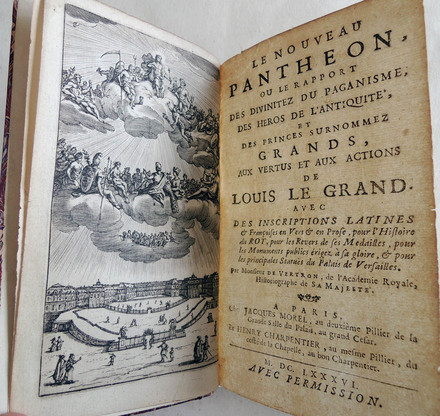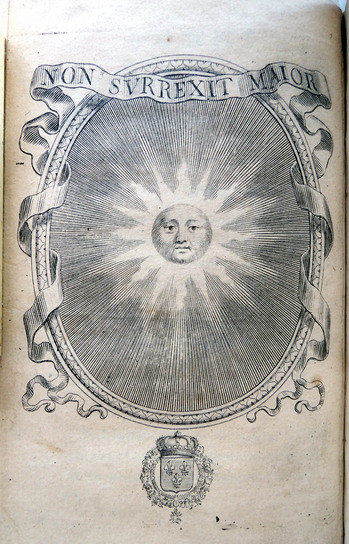Claude Charles Guyonnet de Vertron (1645-1715), Le nouveau pantheon, ou,
Le rapport des divinitez du paganisme, des heros de l’antiquité, et des princes surnommez grands, aux vertus et aux actions de Louis le Grand (Paris: Jacques Morel; Henry Charpentier, 1686). Graphic Arts Collection (GAX), Item 6576801
The frontispiece and plates are engraved by Jean Sauvé (1635-1692), who not only kept a studio on rue Saint Jacques in Paris but also worked in Bologna and Munich.
“If Louis XIV abandoned the traditional pubic state ceremonials of his predecessors,” writes Ralph Giesey, “he created in their stead a private, palace-centered ceremonial life for himself as grandiose as any in the annals of western European history. The cult of the Sun King, elaborated in art and architecture at Versailles and Marly and acted out in a daily ritual lived by Louis XIV for several decades, has not yet received the comprehensive study it deserves…”
“The official emblem of His Majesty is a resplendent sun shining over a terrestrial globe with the device Nec Pluribus Impar, Not Unequal to Many, which means to say His Majesty is equal to many kings. …All the world knows the image of His Majesty as Sun King from the myriad of engravings that have been printed and the host of medals issued from the mint. …”
Giesey continues, “I find myself unable to respect the classical themes in the cult of the Sun King the way I do analogous elements in his predecessor’s ceremonials—as, for example, in royal entries. Revival of the virtues of the pagan world during the Renaissance had meant a broadening of the base of humanitas in western society; Louis XIV made the pagan world seem to be an allegory of his own personal life.”
“The cult of the Sun King postulated Louis’s Divinity on a colossal scale without risking the taint of sacrilege. Louis XIV emancipated himself from old royal ceremonials that had brought the ruler together with his subjects in public forums and created in their stead rites of personality carried out in his private dwellings. L’état, c’est moi whether or not Louis XIV ever uttered those words as a motto of his political conduct, they do catch the ineffable spirit of his ritual life.”
Ralph E. Giesey, “Models of Rulership in French Royal Ceremonial,” in Rites of Power: Symbolism, Ritual and Politics Since the Middle Ages, edited by Sean Wilentz (Philadelphia: University of Pennsylvania Press, 1999). Firestone JA74 .R56 1985



